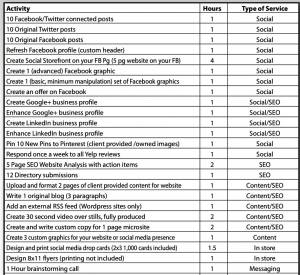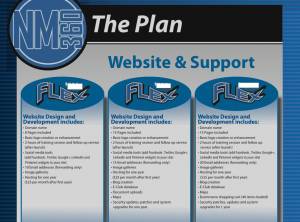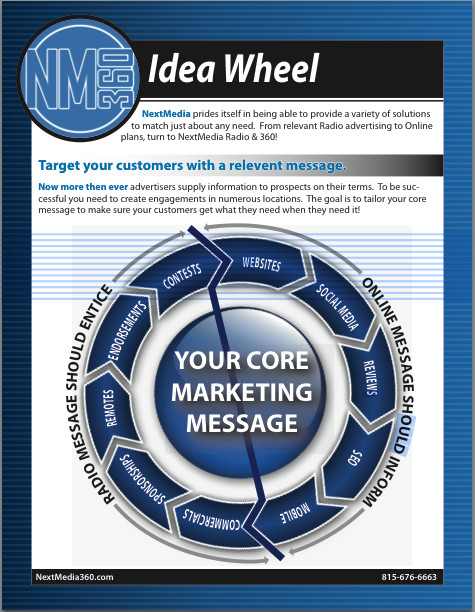NextMedia Group's digital services division upsells 41% of radio advertisers
Company: NextMedia Group, owner of ten radio markets, six outdoor markets and NextMedia360, the digital division.
Markets: Radio: Canton OH; San Jose CA; North Texas; New Bern, NC; Myrtle Beach, SC; Saginaw, MI; and 4 suburban Chicago clusters. Outdoor: Virginia, Wisconsin, Colorado/Wyoming, Virginia, South Carolina and North Carolina.
Contributors to this report: Brian Foster, Vice President, NextMedia 360; Don Guisinger, Interactive specialist, WHBC in Canton, Ohio.
Initiative: NextMedia 360, a digital services agency
Challenge: NextMedia Group's executive team realized that in order to stay relevant, its radio stations needed to address fundamental changes in the way people shop using the internet to research goods and services.
Marketing revenues were increasingly divided between old school "push advertising," such as the radio stations and billboards the company already owned, and new forms of "pull" advertising as consumers go to the internet to "pull" more information on what they need.
"We had to look ahead of our noses, past radio to the larger issue," Guisinger said.
"We sell radio every day, we're good at it. We know how to get people into stores. And we know people habits have changed; they don't go window-shopping at a physical shore. they are shopping online."
To make matters more interesting, in 2008 high speed internet was reaching critical mass almost simulataneously with the global recesssion. This convergence spurred the team to action.
Strategy: The team identifed five core managerial "beacons" or goals to drive long term plans:
1. Create exclusive digital revenue
2. Increase share of buy per customer
3. Reduce on-air clutter
4. Reduce advertiser churn
5. Develop deeper relationships with listeners
An internal divsion was formed, NextMedia360, to further these objectives.
First two years
From 2008 to 2010 the new division focused on strengthening existing platforms with four key initiatives.
• Partnering with Triton Digital to:
- Create engaging radio station websites
- Introduce AAC+ formatted streams
- Engage listeners with their loyalty club at awards points when listeners register, click on an ad, attend a remote and other forms of engagement, in returns for point and enter to win contests. The average listerner, for example, at WHBC may havae 20,000 points and at 100,000 be entered to win a raffle for an iPad or electronics gift card.
• Releasing a mobile application for BlackBerry, Apple and Android with Airkast.
• Increasing engagement between listeners and the radio station playlists via Tune Genie.
• Monetization of these efforts through display advertising and streaming solutionsNext two years
A key take-away from selling digital banner ads locally was that customers "kept saying they weren't interested in advertising for reasons that all pointed back to their web site. They hated their sites," Guisinger said. They also wanted CMS systems they could easily control.
From 2010 to 2012, Next Media360 moved into selling digital services, starting with web site design. This also also served the goal of reducing advertiser churn.
"When we start to manage (advertisers) online content, our relationship deepens adn the overall perceived value ...goes through the roof," Foster said.
Initially the services division started out with one builder using Joomla teplates. As the division grew, however, Director of Operations April Wilson moved the effort to WordPress plaforms. Today an in-house team of WordPress experts have supported 250 web site sales. Newer WordPress sites also have responsive themes that optimize sites on mulitple devices.
The consulting division
In 2011 NextMedia360 added a consulting division to provide additional services:
• Web site updates and blogs
• Facebook and Twitter posts
• Custom Facebook graphics, store front
• Google+ and Linked in business profiles
• Pins to Pinterest
• Directory submissions
• 30 second video over stills
• Design of flyers and social media drop cards
• Limited development of mobile apps using Seattle Clouds. For example, in Canton, Ohio, a football app updating scores and highlights was created, and an exclusive sponsorship sold to a local health care company.
• Reputation management
• SEO services, which in this case means consistent content creation for sites with whom the station has an ongoing relationship to "manage updates."
"We have road map for managed accounts; SEO is a result of all the work we are doing. While back-links and directories are important and we address them, many of the older tricks are going away in place of consistent content creation," Foster said.
The content support team includes seven people who service the 10 markets and 33 stations: Two people who build sites, 4 in support and an executive. All the services use third party technology (resources included in this repart and listed at the bottom under "resources). There are no programmers on staff.
Pricing and packaging
The style of sales focuses on the needs analysis, through there are also some packages. A popular package is the "Flex plan" which includes three tiers that top out at around $1000 per month. In addition to the web site build and hosting, the annual service agreements allow customers to pick and choose two, four or six hours from a variety of hourly services. The station schedules a 30 minute monthly phone meeting to review the site and schedule the next group of posts, updates, etc.
Here is a list of the service units customers can slect:

The base tier includes an eight page WordPress site build, logo creation, social media tools (Facebook, Google+, Pinterest and Linkedin widgets added to the site), ten email addresses for forwarding, an image gallery and hosting, plus the two hours of services. At the next level, the web site is 15 pages, plus blog creation, an E-club database, mpas and system upgrades, with the four hours of services. The last tier also includes an e-commerce shopping cart with up to 40 items loaded and 6 hours of services. Here's how the packages are presented:

Hourly service packages are also sold separately without packages.
"This has been very popular in all of our markets. No one gets into business to worry about Twitter," Guisinger said.
Sales Organization
In addition to the corporate support team, each cluster has an Interactive Specialist in-market (the outdoor department has one central specialist) who works with existing sales teams to develop revenues.
In Canton, for example, Guisinger supports six sales reps, each of whom has a NextMedia 360 budget and is asked to include some form of digital in every proposal, "even if it's a small streaming order." The specialists also evangelize a customer-centric approach.
"I don't really like pre-designed packages," Guisinger says. "My job is to go with the radio sales staff, to meet with clients and find what those needs are, then customize a program that includes radio and interactive."
Foster added that teams "focus on explaining and developing push/pull marketing...and the four stages to a sale. First, the initial information stage, in which a consumer will make a snap decision to find more information or not. This is the information and interest stage that radio is good at, getting the word out and creating a buzz."
"Then research confirms whether or not they want to make a purchase decision. NextMedia360 is designed to reach consumers in the (last two) research and purchase stages."
Guisinger says the Interactive Speciallsts encourage reps not just to simply selling digital service packages, but also to integrate them with the "push side" - onair and banner ads - so that "it is a complete campaign."
Results
• Mobile apps have been downloaded more than 750,000 times.
• The division has developed 250 web sites, with the demand still growing. "Believe it or not ...(some merchants) are using Web 1.0 sites. They may even have absolutely no website or a site built in 1997," reports Guisinger.
• The division is profitable and top line revenue is growing in the high teens year over year.
• 41% of the group's customers have used a NextMedia360 product in first eight months of 2012, an increase of 20% over the same period in 2011.
• Advertisers who use NextMedia360 products with traditional campaigns tend to increase their overall budget and have less attrition.
"They realize if they have a radio campaign that drives consumers to a website that is horrible, they will go to a competitor. If they have a good website they have a better chance of closing business and are more confident in buying long term radio campaigns. A poor website can cost advertisers money due to lost leads," Guisinger said.
• Streaming, display and website builds are the most popular offerings.
Lessons learned
• Customers were surprised to see a radio company approaching them with a rounded multi-media strategy. "Why is WHBC selling me a web site build?"
•"One of our initial beliefs in working with reps - these street warriors - was that they would be motivated (to embrace 360 services) by the hope of gain, to make more commissions. But we had it exactly backwards," Foster said. "Fear of loss was a much larger motivator...If we understood this; we would have changed our initial approach. Our training and packages work best when we receive solid feedback directly from the sellers in the trenches."
• Fosters believes they could have started NextMedia360 consulting services earlier, in 2008, instead of 2010; "we would have been further ahead and more established."
• “We see on a regular basis clients starting with a new website and then adding substantially to their radio campaigns 90 days later. Now that they have a beautiful new website, they need traffic," Foster said.
Many thanks to LMI members Brian Foster, Vice Pr

The author, Alisa Cromer is publisher of a variety of online media, including LocalMediaInsider and MediaExecsTech, developed while on a fellowship with the Reynolds Journalism Institute and which has evolved into a leading marketing company for media technology start-ups. In 2017 she founded Worldstir.com, an online magazine, to showcases perspectives from around the world on new topic each month, translated from and to the top five languages in the world.






